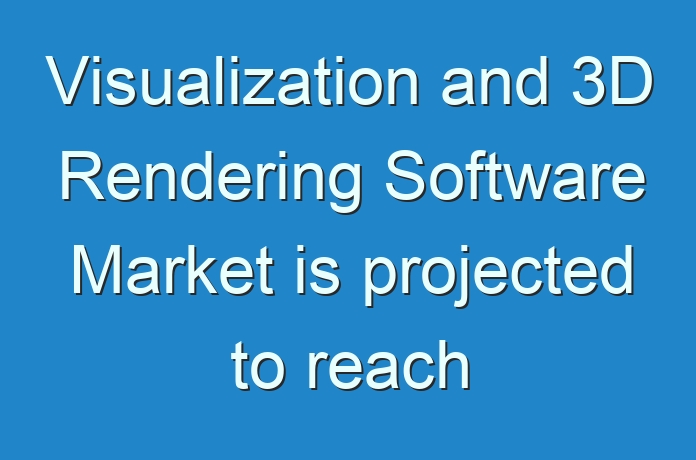
According to a new market report pertaining to the global visualization & 3d rendering software market published by Transparency Market Research the global visualization & 3D rendering software market was valued at US$ 1,097.7 Mn in 2019 and is projected to reach US$ 6,332.1 Mn by 2027, at a CAGR of 24.5% during the forecast period from 2020 to 2027. Expansion of the visualization & 3d rendering software market can be attributed to less time required for 3D rendering activity across industry segment with reduced cost and major introduction of 3D enabled display devices in public places and business sector. North America is anticipated to lead the global visualization & 3d rendering software market in terms of revenue, followed by Europe, during the forecast period.
Request a sample to get extensive insights into the Visualization and 3D Rendering Software Market
Visualization and 3D rendering software are used for creating graphical interfaces and displays for software solutions and converting 3D models into 2D images or videos. Visualization software includes graphical objects and components which are used for applications and displays with the help of software editors. These software are used for graphical user interfaces in industries to display the required information in an effective manner. 3D rendering software are used for creating 2D image or animation from the established scene with 3D effects. Visual presentation is the most effective form of marketing nowadays as social media has become immensely powerful channel. 3D rendering helps in presenting the promotional photos and videos in an attractive way. This visualization and 3D rendering software are used extensively in architectural & designer firms, visual effect companies, automotive, telecommunication and other industry segments. Rendering is the final process of creating the actual 2D image or animation from the prepared scene. 3D rendering software takes user-created 3D models and place them into 3D environments or images. With 3D rendering programs, graphic designers and media developers can insert disparate objects and characters, imported from 3D modeling programs, into a graphically appropriate settling. These 3D rendered images are often scalable, navigable, and interactive. 3D rendering software may include some animation tools or these software may integrate with animation software to bring scenes to life, for later use in video games, movies, television shows, or other media. These programs can also have features such as lighting and texturing, which can add depth and realism to scenes. Visual artists in entertainment, automotive, architecture, advertising, and web design industries utilize these tools to create lifelike scenes for use in media or client engagement purposes.
To understand how our report can bring difference to your business strategy, Ask for a brochure
The process of 3D rendering is increasingly being used to convert images of buildings, animated characters, sceneries and other such 3D geometric models into images with desired simulation, optical effects and other such innovative characteristics. It enables architects, interior decorators and designers to design and view the construction and interiors much before they are actually made. In the field of engineering, the software is being used to conceptualize, design, represent and analyze parts of machines. Less time required for 3D rendering activity across industry segment with reduced cost, Just-in-time-marketing has increased the need for creating marketing collaterals in short period of time, and Major introduction of 3D enabled display devices in public places and business sector are the major growth drivers for global visualization & 3D rendering software market.
On the basis of deployment type, the visualization & 3D rendering software market is categorized into on-premise and cloud. On-premise based 3D rendering software comprise the largest segment, accounting for a market share of approximately 61.8%. This on-premise based deployment market is expected to steadily decrease over the forecast period. The cloud based deployment of 3D rendering software with take steady growth over forecast period, thus, they are expected to witness significant demand in the global visualization & 3D rendering software market.
Buy Now:
https://www.transparencymarketresearch.com/checkout.php?rep_id=11822<ype=S
On the basis of end-use industry vertical, the visualization & 3D rendering software market is segmented into the Manufacturing, Construction, Media & Entertainment, Healthcare, and others segments. Majority of the architects are more likely to adopt this 3D rendering software technology for their projects, which increases the use of visualization & 3D rendering software. The construction industry vertical is the major contributor for usage of 3D rendering software. This is because it’s increasingly usage by Architects, Designer, BIM modelers, etc. After construction, the usage of 3D Rendering Software for Media & Entertainment industry mostly in North America is significant due to need of 3D rendering software for animation, VFX, digital media, film industry, etc.
North America and Europe are the key regions driving the growth of the global visualization & 3D rendering software market. But over the forecast period, the Visualization & 3D Rendering Software market is expected to grow significantly in Asia Pacific region due to its growing economy, large number of construction projects, and population growth
Stuck in a neck-to-neck competition with other brands? Request a custom report on Visualization and 3D Rendering Software Market
In 2018, key visualization & 3D rendering software vendors included
- Autodesk Inc.
- Dassault Systems
- NVIDIA Corporation
- Chaos Group
- Abvent Group
- Cebas Visual Technology Inc.
- Next Limit S.L
- Luxion Inc.
- OTOY Inc.
- Act-3D B.V., etc.
TMR’s Latest News Publication –





